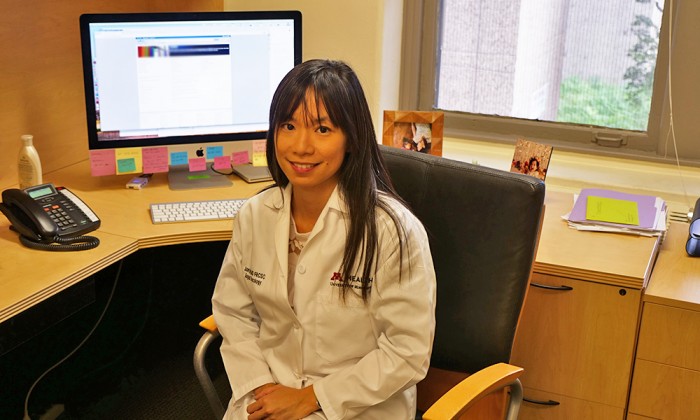
The first step is to meet with a surgical oncologist, who is a surgeon specifically trained in treating cancers. At that visit, the physician will meet with you about the imaging findings, the treatment overview for breast cancer and the next steps. For most women, surgery is the usual first step, and different surgical options will be discussed.
Depending on the type of breast cancer, some women’s first step will be chemotherapy. Your surgical oncologist may also talk about other tests that are needed, such as a laboratory test to look for a genetic mutation.
“It can be very difficult to process all of the information at your first appointment after a breast cancer diagnosis. I encourage all patients to attend their appointments with their family members and/or close friends. They can help to lend a shoulder to lean on as well as another set of ears for all this information. I have witnessed what a difference having support from family and friends can make.”
Dr. Jane Hui, M Physicians Surgical Oncologist
Surgical Options
There are two parts to any breast cancer surgery: the breast and the axilla (armpit).
For the breast, the two general options are a lumpectomy or a mastectomy. A lumpectomy removes only the cancerous portion of the breast while the remainder of that breast remains, whereas a mastectomy removes the entire breast. Patient preference, size of the cancer, how close the cancer is relative to the nipple and how healthy the patient is overall are some of the major factors that help to decide which is the best option for surgery of the breast.
The second part of breast cancer surgery involves the axilla (armpit). There are two different axillary surgeries, which differ on how many lymph nodes are removed from the axilla. The purpose of this surgery is to check to see if there are cancer cells that have spread to the lymph nodes in the axilla, and if so, to remove them.
It is because of these many options and decisions her patients face that inspired Dr. Hui to enter the profession.
“I became a surgeon because I wanted to ‘fix’ things,” she said. “But I also enjoy making a connection with patients and helping them navigate such a difficult point in their lives. The surgical oncologist’s relationship with her patient is unique and immensely rewarding. When I get to deliver good news, it is a feeling like no other and is the very reason why I became a doctor. When I have to deliver bad news, I try to gently, but honestly, guide my patients through what to expect and learn from them what strength and grace is all about. It, too, is the very reason why I became a doctor.”
Continuing to Advance Treatments
Surgical oncologists now practice in multidisciplinary clinics. This means that surgeons, radiation oncologists and medical oncologists collaborate to discuss complex patients and treatments.
Techniques in breast cancer surgery have evolved so that it may be possible to achieve acceptable cosmetic outcomes with a lumpectomy or with nipple-preservation for mastectomy, though these possibilities are dependent on the details of the specific patient. Chemotherapeutic agents are also evolving, allowing oncologists to tailor recommendations for chemotherapy based on tumor-specific genomic data, which was not a possibility in the past.